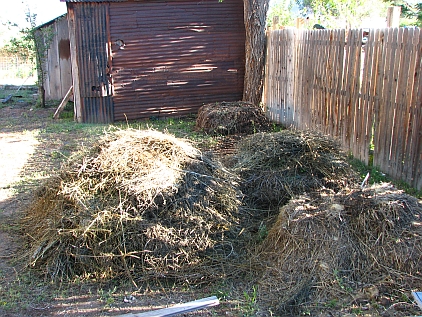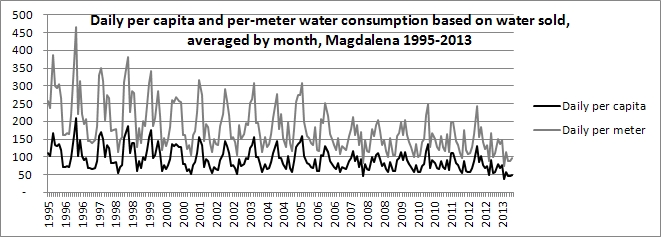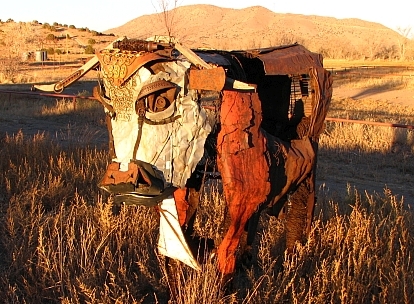Sanitation
Sanitation refers to the disposal of wastes, including manufactured materials (trash), food waste (garbage), and human and pet bodily excretions. Other wastes might be animal carcasses, but except for the occasional mouse, I don't generate much in that line.
Trash and garbage
I use "trash" to mean material that doesn't decompose and "garbage" to mean material that does. This is a useful distinction, because trash can be separated into recyclables (cardboard, paper, glass, metal, plastic, etc.) that will be remanufactured by humans into products, while garbage, if treated properly, gets recycled by other organisms into soil organic matter and ultimately plant material. As you might expect, many residents here, as in many other towns, don't distinguish between these kinds of waste.
The village provides a trash/garbage pickup service and the material is taken either to a transfer station near town, or to the landfill near Socorro, 26 miles away in the Valley. Residents can bring other waste to the transfer station (visible in the lagoon image below) for a small fee.
Recycling trash
The transfer station actually has a compactor and uses it to bale cardboard if it's brought separately (there's no one separating it from the rest of the trash), which is given away to someone who hauls it away for sale to a recycler. If you want to recycle anything else, you must take it to Socorro or (for plastic and glass) up the Valley to Los Lunas. So recycling is still undeveloped in the village—a community activity that remains to be organized. I carry my materials to the necessary centers when traveling there, and that's all I'll have to say here about trash.

Recycling garbage on the property
The cellar under my main house is a good place for a worm bed, cool in summer and cool but not freezing in winter. The bedding was made from composted steer manure (bought from a garden-supply store in Socorro before I had any compost made) mixed with some old potting soil I found in one of the greenhouses. The redworms were ordered from a Colorado outfit. I bury all my garbage here and pour about 5 gal of water over the bed every other day (you'd think it would stay damp in a dank cellar, but it dries out fast in this dry climate). The garbage on the top was upturned by a mouse (since slain), and there really could be a couple more inches of bedding. But the worms are doing fine and a bed of this size could easily handle all the garbage of a family of four (but meat scraps, grease, and citrus are not suitable for worm composting). In summer 2014, since I don't generate very much garbage, I started feeding the bed aged horse manure that I get free from a local horse fancier.
Humanure handling
The village sanitation system drains from most (not all) properties into a set of four lagoons N of the village.
The transfer station is just above the rightmost lagoon. This system was built only in the last 15 years and before it there were cesspools (now illegal) and septic drain fields, some of which persist. The sewer lines don't serve all properties, in particular those on the S end of the village.
Of course graywater and blackwater drain into this system. It seems to work "fine", if you ignore the waste of water and nitrogen and overlook the backing up of drains into which elm roots find their way, up in the village. Some 50% of the water from Albuquerque sewage is recovered by treatment and fed back into the river. Ours just evaporates. What happens to the solids that settle out? In principle they'll be hauled away every few years, though where "away" is I haven't found out yet.

My two houses have toilets connected to this system, so my sanitation is all up to code. However, as you might guess, I'm opposed to diluting my poop and pee with drinking water to get rid of it. I'm quite fond of the stuff, though not in its raw form. And I'd rather drink drinking-quality water than pollute it with that stuff.
Why am I fond of it? Because pee contains much of the P and N that we excrete, and poop contains the rest, plus plenty of organic matter. Crops need P, N, and organic matter. P is manufactured from mined phosphate rock, which is running out. You don't hear much about the phosphate crisis, but you will. N is fixed by the Haber–Bosch process from air into ammonia, and it uses a lot of energy. Why dig up stuff (or pull it out of the air), use it once (by growing crops with it), pass it once through the human gut, and throw it into the sea (via our rivers) as treated sewage, or into lagoons? Why not keep that P and N around and grow more crops with it?
You can, by collecting urine and composting humanure. You can buy a fancy composting toilet or you can use a DIY solution. For learning more about these, two sources are The Composting Toilet System Book and Joseph Jenkins' site and book, The Humanure Handbook.
All my urine is collected, diluted 10:1 with water, and used for irrigation. Because urine of healthy people is sterile, there is zero pathogen risk with this practice, and soil microbes quickly deodorize the urine. I dump it in my tree basins and on my vegetable garden, whichever hasn't been watered lately. You don't put undiluted urine on land. It's too strong and will burn growing plants, plus it will stink up the area like a New York City subway because it won't be degraded fast enough in the soil.
How about the poop?

A properly made compost heap develops sustained temperatures above 150°F, killing all pathogenic organisms and parasites. Human waste, with a suitable carbonaceous material (like pine sawdust) diluting it, is quickly turned into odorless compost when dumped into the middle of a hot compost heap. I was surprised how quickly (three weeks, in my experience) it became odorless even in a cold heap that had already passed through the hot stage. The uppermost heap in the image was originally twice the height, and has shrunk as the hay from which it was built decomposed along with the alpaca manure that was used for the original N source. It contains one five-gallon bucketload from my DIY toilet, whose contents have long since decomposed. Like all heaps to which humanure is added, it's left for several months to ensure elimination of pathogens and parasites (which don't survive well outside a host, especially after being cooked). Then the compost, which smells like fertile garden soil, can be used anywhere you like. I'll put it around my fruit trees.
What do I use for a toilet? A five-gallon poly bucket (with a cover) with sawdust, and another container of sawdust, with a scoop, to cover the daily contributions. When I get around to it I'll build a nice plywood box to hold the bucket (like this) with a standard toilet seat and cover on top. There's no more stink than from a flush toilet and no flies, in a properly screened house. About every month, one of the compost heaps has the top foot of material removed, the full bucket is dumped into the middle and rinsed, and the top material is replaced. No stink, no flies, no dogs digging, no drainage, no nothing. The heaps are 50' away from the neighbor's front door, behind the privacy fence, but they could just as well be 10' away. She wouldn't know the difference, nor would you.
I also compost the manure of two cats. I've quit buying calcined-clay cat litter, which besides being expensive (and usually impregnated with an unpleasant chemical "fresh" scent) does nothing for soil or plants. Instead, their litter box gets the same screened pine sawdust that goes into mine. It suits them fine, clumps pretty well and, if you keep it cleaned out, doesn't smell. And it contributes organic matter to the soil.
Note that for building the compost heap that you'll be using for the Jenkins method of humanure recycling, you need another source of N, typically animal manure. Using the humanure directly, though it would work, would require layering it along with the plant material, and this would be a way nastier operation than using relatively low-odor manures like horse or alpaca and would take longer to ensure that it gets decomposed. Burying the humanure in an already built heap is much more convenient and ensures that it's all in the hot part of the heap.
To digest the compost even better for feeding to plants, I've begun burying a trowelful of worm bedding containing a few redworms in the heaps after they've cooled down. In the following (2014) early summer, when the first heaps were spread, I did see some redworms in the compost, but it hadn't been kept moist enough over the winter and spring for them to multiply a lot. I raked aside the mulch in my fruit tree basins, spread compost, and then restored the mulch. I'm hoping this will inoculate the soil with worms, which will loosen and aerate it. Another heap was tilled into various garden patches.
Side note: Behind the corrugated shed wall in the image above is a double (side-by-side) outhouse, no longer in use. Apparently people used to like company in the privy. Never mind.
Could, say, Rio Rancho, Albuquerque's bedroom suburb, adopt these practices for its residents? No, it takes too much hands-on management and public participation and people living in apartments don't have big back yards or access to materials to build compost heaps. Shit and piss are unpleasant subjects; modern people don't think of them as valuable resources, although they are. All civilizations in history have used human waste ("night soil") as valuable fertilizer, though composting it by modern methods with plant materials giving a suitable C:N ratio, to make it odor-free and sanitary, is only a hundred years old. In modern cities, the only practical option is to keep using the public water-based sanitation system, and recycling what water and solids can be recycled.
Could or would Magdalena residents adopt the DIY composting toilet? A few, sure, but for most, it's not a realistic public sanitation plan. What might be? Perhaps constructing a wetland/irrigated woodland that would turn the wastewater and soluble nutrients in the lagoons (whatever didn't recharge the groundwater) into forest and firewood, and separately recovering and composting the solids for garden and orchard use.
Water use in sanitary waste disposal
You may have noticed that there's not much need to flush toilets with the above scheme. How often do you flush the toilet where you live? Twice a day per person? More? There goes five to ten gallons of drinking water, per person. A lo-flo toilet will reduce this, but not eliminate it. When I need to flush (which isn't often), I use the cold water that runs out of the bathtub faucet into a 2-gallon bucket while I'm waiting for the hot water for my shower to arrive.
Do you know how much drinking-quality water you use every day? Cooking, drinking, dishwashing, laundry, hand washing, teeth brushing, lawn watering, garden watering, toilet flushing, showering, bathing.... I'm betting at least 50 gal/day, probably much more. At the time of the well failure in Magdalena last June, a typical daily consumption rate, for a village of fewer than 1000 souls, was 200,000 gallons, or more than 200 gal/day per person. The long-term, year-round daily per capita consumption, since 1995, has been 92 (70 from December to April, 109 from May to November), based on metered water. If you count all the water pumped, which was half again the amount paid for, the daily consumption was 140 gallons per man, woman, and child. The plot below is based on records provided by the Village at my request.
I suspect these numbers are typical throughout the West, and have been told that the average loss of 34% of the pumped water (by leakage and theft) is also not out of the ordinary in NM.
For regular personal use, I average 200 gal/month, about 6 gal/day—often less, especially in the summer. For two construction projects where we mixed concrete, l used several hundred more gallons per month, over three months.
This frugality involves only a little more time and attention than a habit of thoughtless water consumption without reuse, and my body, clothes, and dwelling are as clean as anyone else's. Plus I grow a garden and fruit trees and am preparing to support two greenhouses, all without using tap water.
Compared to the water budget of a poor housewife in sub-Saharan Africa or the Algerian or NW Indian desert, even this allowance is pretty lush.
Water, certainly in Magdalena but in most of the western U.S., is artificially cheap, like some other resources including fossil fuels. We aren't paying the bill that will be presented to us down the road. When it is, we'll play victim, as though we hadn't been warned for many years that the bill was coming.


